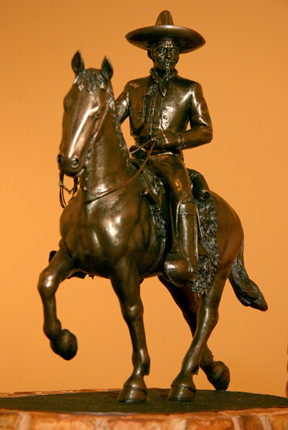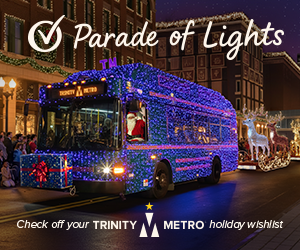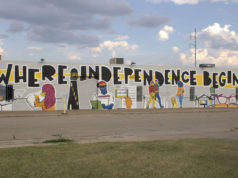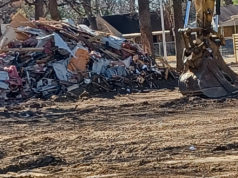A long-awaited statue honoring Hispanic cowboys is supposed to reach its pedestal by summer.
By JEFF PRINCE
A vaquero could have straddled his old caballo and pushed thousands of rangy longhorns from Mexico to Fort Worth in less time than it took community leaders to raise money for a statue on the North Side. But patience usually prevails, and an idea that was bandied about in this town for more than 20 years is growing ever closer to reality.
The city’s first public art to honor Hispanic culture – a 10-foot-tall bronzed sculpture of a vaquero on horseback – is being prepared for casting at an Azle foundry and could be completed and installed on North Main Street by summer, maybe even spring.
a vaquero on horseback – is being prepared for casting at an Azle foundry and could be completed and installed on North Main Street by summer, maybe even spring.
“This is a first for Fort Worth,” said Justice of the Peace Manuel T. Valdez, who served as head of the statue committee. “It’s a major piece that is important to Fort Worth, especially to the Hispanic community and to the city’s history. [Hispanics] don’t have anything; it’s like we don’t exist. Maybe with a statue like this, the Hispanic community that was so important to the development of Fort Worth will say, ‘Hey, we are recognized.’ “
Community leaders, with assistance from former City Councilman Jim Lane and current Councilman Sal Espino, established a private fund-raising campaign in 2005. They had high hopes of raising a quick $110,000 to qualify for a matching grant from the city’s public art department to pay Dallas-based sculptors David Newton and Tomas Bustos to create a life-sized sculpture. But the effort to raise money crawled along at a contented cow’s pace. Hurricanes Katrina and Rita hit hard that year, and the economy was starting to tremble. Also, Valdez and others were new at public art fund-raising. They preferred a grassroots approach, seeking a large number of small donations rather than relying on a few rich benefactors or foundations. Not only did they want the little people’s money, they wanted to spread the word about vaqueros and Hispanic culture.
Three years passed before the money was raised.
“We knew it was going to take time to get money from the community,” Valdez said. “You really have to talk it up and make individuals understand what it stands for and why we’re having it.”
The committee cast its fund-raising net citywide rather than concentrating only on the largely Hispanic North Side.
“These cowboys and vaqueros were partners way back then and relied on each other in the endeavors they took on,” Valdez said. “They should be partners now. This statue belongs to the city of Fort Worth.”
Many of those donors will be asked for suggestions on a grand unveiling.
“In the next couple of weeks I’m going to try to organize as many of the Hispanic organizations and other organizations that have been involved to get them all in one room and come up with a plan on how we’re going to unveil this,” he said.
The project took decades to reach fruition, but the wait worked out in the long run. Back in the 1970s and ’80s, North Main Street was a run-down mix of small shops, deteriorating buildings, and boarded-up businesses. A statue might have looked like a pearl in a cow patty. But in recent years, the city built a red-brick sidewalk and plaza and oversaw construction of the fabulous-looking (but still mostly unleased) three-story Fort Worth Mercado.
Meanwhile, renovation of North Main Street began at about the same time the committee was choosing a sculptor. Together, the sculptors and city street designers created an attractive setting for the statue – a rock-bordered concrete base on a newly redone traffic island bordered by North Main Street and Central and Ellis avenues. The city dedicated the land, built the pad site, and paid for half the sculpture. In the end, the city underwrote about $245,000 of the project’s $356,000 price tag.
“The timing was perfect because the city was redoing the streetscape, and the artist was able to work with them to develop the design of the traffic triangle,” said Martha Peters, director of Fort Worth Public Art, a program of the Arts Council of Fort Worth and Tarrant County designed to fulfill the vision laid out in the city’s public art master plan.
Statues honoring Hispanic culture are rare in North Texas, and some attempts have backfired. Valdez has seen vaquero statues that are historically inaccurate and, in some cases, condescending. He recalled seeing a statue of a vaquero who was wearing pistols and bandoliers, or leather straps filled with bullet cartridges draped across the chest – something worn by Mexican soldiers or bandits but not vaqueros.
“He looked more like a bandido,” the judge said.
The attire depicted on Fort Worth’s vaquero is based on historical fact.
“It’s not made up or Hollywood; it’s real history,” he said. “It is going to be something the city of Fort Worth will be proud of, and it will be part of the city’s image. It doesn’t look like a bandido or a worker in the field stooped over. It’s a proud cowman.”
Then again, some observers were surprised by the design, which depicts a vaquero sitting somewhat stiffly atop a horse.
“It’s almost like he’s going through a drill,” said Eddie Sandoval, who is on the Fort Worth Herd committee. “It’s an interesting design. It’s not what I would have picked, but that’s not for me to say because I’m not on the [vaquero statue] committee.”
Hollywood movies and early TV shows such as Rawhide typically portrayed movie cowboys as white men, although many African-Americans and Hispanics worked on ranches and trail drives. Journals and books written by white cowboys and authors in the late 1800s inspired Hollywood, but vaqueros had existed in Spanish North America for hundreds of years before then. They taught many white cowboys their trade.
“The statue is very dramatic,” said Doug Harman, a local historian and former Fort Worth Convention & Visitors Bureau president who helped on the fund-raising committee. “It’s going to have a real presence on North Main Street.”
How long it will take for the sculpture to be cast in bronze depends on the foundry’s backlog of work, but the statue could be ready as early as April or as late as June or July, Bustos said.
The project’s educational and cultural elements attracted the city’s public art program, which was created in 2001 and dedicated to establishing art that resonates within neighborhoods citywide, Peters said.
“Part of our mission is to include the various histories and cultures in public art in the city,” she said. “The vaquero sculpture certainly meets that criteria to tell a story that hasn’t been told before.”











